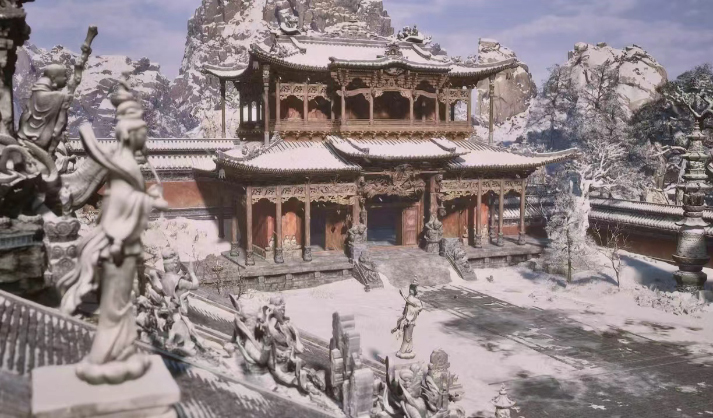Sun Wukong, the legendary Monkey King known for his ability to transform into 72 different shapes, travel vast distances instantly on a cloud, and battle a myriad of monsters and demons, is a character deeply ingrained in the childhood memories of nearly every Chinese person.
Since his debut over 500 years ago in the classic novel Journey to the West, Sun Wukong has been a prominent figure in different forms of popular entertainment, including novels, TV series, dramas, movies and video games.
Most recently, the Monkey King has extended his reach into the global media landscape, captivating millions of gamers with his epic tale and dynamic combat style. The action game Black Myth: Wukong, developed by Game Science, a video game developer backed by Chinese tech titan Tencent, draws inspiration from the age-old novel Journey to the West. In this game, players step into the role of the Monkey King himself, embarking on his legendary “Journey to the West” while overcoming a myriad of formidable challenges along the way.
“Look how lifelike this monster is, I can even see the mane on its back,” gamer Bianzi exclaimed to audiences when playing the game during one of his livestreams. “The character moves and wields the Jingubang (or golden cudgel—Sun Wukong’s traditional weapon) exactly like I remember. This game is a throwback to childhood!”
“In addition to the high quality of the game itself, the culture surrounding Sun Wukong appeals to many young people,” Ma Jing, a gaming industry expert told news portal Bkeconomy, adding that the integration of a national household “brand” like Journey to the West is essential to the success of this game.
International spotlight
As China’s first attempt to create an “AAA” game—an informal classification in the gaming industry that signifies a high level of investment in time and a big budget—Black Myth: Wukong had emerged as a massive success. Since its release on August 20, the game has attracted over 2.1 million players worldwide at the time of writing and topped weekly sales charts in 12 countries, including the United States, Singapore, Brazil, Canada, and Italy. It also achieved the second-highest number of concurrent online users on Steam, a global gaming platform.
According to statistics from global game review platform Metacritic, over 54 media outlets worldwide have rated the game with scores above 8 out of 10. Respected gaming outlets such as IGN China, IGN Brazil, Game Blast, and GamingBolt have awarded the game a perfect score of 10.
As of August 23, total sales of Black Myth: Wukong had exceeded 10 million sets. It had also achieved the peak of 3 million simultaneous online users.
But Black Myth: Wukong has captivated not only Chinese gamers who grew up familiar with the original tale but also players worldwide, even those unfamiliar with its cultural background. The game is impressing players with its stunning 3D special effects, exquisite character models, smooth performance, meticulous action and character details, and engaging storylines.
“I heard that—after purchasing the game I did some research online—in the original novel, Sun Wukong and his peers overcome 81 obstacles to accomplish their goal,” Kumar, a Canadian gamer who prefers to go by his first name, told Beijing Review. “I also watched the game’s themed video, which gives you a preview of the different endings your performance might lead to. This kind of game design pushes you to explore more, and makes [the experience] feel rewarding. I’m on my way to overcome the third obstacle.”
“I think the story of Sun Wukong is very inspiring. His traits, like loyalty, bravery, integrity, flexibility and cleverness, are appreciated across different cultural backgrounds,” said Chinese Filipino Zhou Zekai, who purchased the game upon its release. He added that these universally recognized virtues have contributed to a broader understanding of Sun Wukong’s character and the game’s international popularity.
But despite the overwhelming praise, some players have suggested improvements to enhance the gaming experience, especially regarding the complexity of the storyline, the smoothness of gameplay and translation issues.
Jason Rodriguez, editor of reputed entertainment and culture portal Polygon, reviewed the game in an article titled “Black Myth: Wukong is an epic saga that’s both confounding and spectacular to behold,” writting that the game is very confounding for those who are totally unfamiliar with the basic storyline of Journey to the West. Its numerous, unknown enemies and mysterious cultural and religious concepts, require players to spend dozens of hours “warming up” before actually understanding the game’s plot.
To better grasp the story, many international players have even started reading Journey to the West, leaving thousands of comments under posts with the game’s Instagram hashtag: “blackmythwukong.”
“We were not expecting this volume of users and we underestimated the amount of and the complexity of the translation work,” Feng Ji, founder and CEO of Game Science told Southern People Weekly magazine, adding that his team is forging ahead with an update set to land in September.

Perfecting the details
To lend the game a sense of realism and historical depth, the design team identified 36 culturally significant sites, each with ties to the original Journey to the West story, and meticulously recreated them in the game using advanced scanning technology.
Many players have described the in-game scenes as “spectacular” and “gorgeous” in comments on Instagram.
Of these 36 sites, 27 are located in Shanxi Province, northwest China. These include the Yungang Caves, a collection of Buddhist stone carvings from the Wei Dynasty (386-534); the Wutai Mountain, one of China’s four Sacred Buddhist Mountains; and the Ancient City of Pingyao, an almost perfectly preserved Han city from the Ming Dynasty (1368-1644). This has in turn contributed to a boost in Shanxi’s cultural and tourism industries.
“We first started working with Black Myth: Wukong’s visual team in 2022, helping them to examine, photograph and scan the cultural relics,” Zhang Qing, an official with the Cultural and Tourism Department of Shanxi Province told news portal Guancha.cn, adding that the team’s pursuit of high level visual and artistic effects has set a great example for the province’s efforts to promote its cultural and tourism industries through digital technology.
Over the past two years, Shanxi has partnered with Game Science to release eight short videos showcasing comparisons between the game’s settings and their real-world counterparts, detailing the history of these sites and offering artistic perspectives on their significance. These videos shed light on the cultural background of the game and helped promote Shanxi’s attractions.
“It often takes decades to build up a super IP universe—like the successful examples of Marvel,” Feng told Xinhua News Agency. “I wouldn’t say I want to create a ‘universe’ personally, but I envision a ‘world.’ I hope players can immerse themselves in this mythical world with an Eastern strand and ancient legends, which we will build upon Black Myth: Wukong and enrich it with future efforts.”–The Daily Mail-Beijing Review news exchange item






